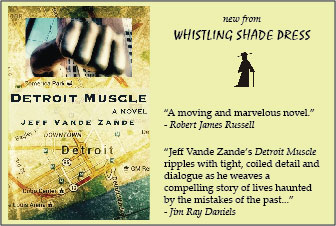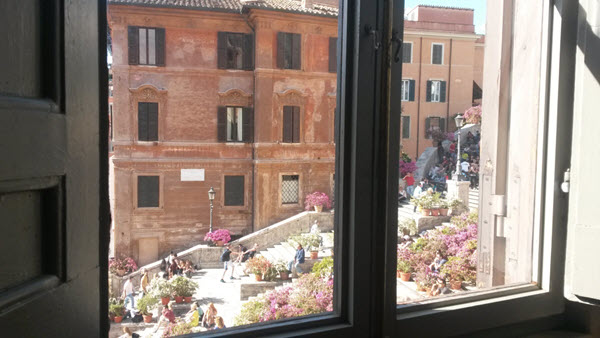
| <- Back to main page |

|
Rome is the city of echoes, the city of illusions, and the city of yearning.
-Giotto di Bondone
The day I stumbled upon John Keats’ home in Rome, the Spanish Steps were a wall of pink. Each sweeping stone stair was covered in baskets of pink flowers for the month of May. It was nearly my last day in Rome, after four months of classes there, and I was treating myself to spoonfuls of tiramisu while dodging street vendors and tourists with selfie sticks. The bittersweet taste lingered in my mouth as I licked the last bit of cocoa dusted cream from my finger. Flower fumes pricked my nostrils.
I wasn’t sure why I came to the Piazza di Spagna that day. The rest of my classmates were hitting up all their favorite gelato places one last time. I came here, alone, for unknown reasons, to a piazza I had walked by every day on my way to class. I passed the fountain of the sinking ship, where children were filling bottles with water, and made my way to an empty spot halfway up the Spanish Steps, peering around baskets of flowers.
With large tiers and thick banisters, the Spanish Steps were built to be theatrical, setting the stage and leading travelers up to the Church of the Trinity at its peak. I loved the Spanish Steps, loved the way they were straining for something higher. Feelings of want were central to my experience in Rome, and I thought the Spanish Steps embodied this. I never ventured to the top for fear the destination wouldn’t be everything they promised.
I relaxed for a moment and took in the scene—all tourists, street performers, sun, and smooth stone. Then I saw something I had missed all the times I’d been here before. It was a little sign that read, “Keats-Shelley House.”
* * *
My high school class was instructed to read Keats’ poem, “Ode to a Grecian Urn”. In it, an image is frozen in time. Two lovers remain forever young and beautiful. They gaze at each other in undying love, but they can never kiss. Leaves never fall from the trees, and a melodist never tires of playing songs that can’t be heard; “Heard melodies are sweet, but those unheard are sweeter.” It was the first poem my teacher explained to us that completely silenced the classroom. The scene is eternally beautiful and eternally stagnant.

A few pages of Keats reveal poems prone to emotion, overly enthusiastic at times and despairing at others, with too many exclamation points. The kind of writing one does when one can’t help themselves. Keats was preoccupied by young love. He had an obsession with Shakespeare. He didn’t have life figured out; he was a medical student who couldn’t stop talking about poetry. And he died young, at the age of twenty-five, long before most writers are said to reach their intellectual peak. In my mind, Keats’ Grecian urn also holds a poet sitting against a tree in the far corner, pen to paper, writing happily and unceasingly, words never to be read.
* * *
Through the door and up a steep spiral staircase, I found a small museum in what was once the humble home of John Keats. It was quiet, a startling contrast from the noise of the piazza outside. A narrow living area held a small fireplace and elegant cherrywood shelves filled with leather-bound books. Red draperies hung by the windows, and a ceramic bust of Keats stood in the far corner. An even narrower bedroom, plainest room of the three, held nothing but a bed and a simple wood desk pushed up to a window overlooking the Spanish Steps. The last room contained glass cases of artifacts and Keats’ original penmanship framed on the wall. One frame held an early manuscript of the poem, “Ode to a Nightingale”, though I wouldn’t have noticed if someone hadn’t pointed this out to me. I couldn’t read any of his scrawly writing.
This is such a humble home, I marveled, breathing in dust and leather. I imagined Keats writing poems and letters at the tiny table by the window and wondered if he traveled to Rome purely for inspiration. Moments later, I would find out this is where Keats battled the tuberculosis that eventually took his life. His doctors suggested the move from England to Italy, thinking warmer weather might ease his suffering. But in my ignorance, I milled about the quiet room, just above the crowded piazza, trying to read Keats’ handwriting and living a vicarious fantasy that never was.
* * *
In my eyes, Rome was the epicenter of inspiration. With its twisted orange trees rising above cracked walls and seedy oranges dusting the air with citrus. With its ancient ruins beside bustling streets that made me feel both new and old, and possibly wise in my new-oldness. With its skinny Italian women who lived off espresso and cigarettes, and the men who waved their arms and yelled wildly from their tiny cars. Fast-talking strangers would chastise me in words I could not understand, which did nothing to remove my gawky romantic stare.
I was drawn to Italian art, especially Michelangelo’s Sistine Chapel, where he painted the ceiling with scenes from the Book of Genesis. Shortly after seeing it in person, I learned that in addition to being a painter and sculptor, Michelangelo was also a poet. He wrote over three hundred poems in his life. He wrote about things like God, beauty, and death but never felt he had a real talent for it.
Standing in the Sistine Chapel months before, craning my neck among the crowds and security guards shouting “Silencio!”, it first occurred to me that Rome was trying to tell me something about beauty and art. Rome seemed to beg the question, Why devote life to anything but great art?
In that moment I could not come up with a satisfactory reason. There was never anything so vital as art.
* * *
The quiet was broken unexpectedly by twenty or so school children filling in the edges of the room for a tour. Our guide, Marta, began telling Keats’ story as it pertains to these little rooms.
“The doctors were very confused,” Marta said, dramatically for the children. She spoke English with a slight Italian accent. “We know tuberculosis causes people to cough up blood, but the doctors had another idea. They thought the reason Keats was coughing up blood was because he had too much blood for his body to handle. They thought he needed blood to be taken out of him in order to heal.”
The children gasped, which also could have been me.
“Every week, sometimes multiple times a week, the doctors would stick a needle in his arm and take blood out of him,” Marta continued.
I watched all eyes stare at Marta with vaguely horrified expressions.
“And when he continued still, to cough up blood,” Marta said, “the doctors decided to put him on a strict diet so blood wouldn’t flow to his stomach. He was only allowed a little water and bread each day.”
The children stared at her in disbelief. Some laughed a little.
“This was the medical opinion for that time period,” Marta explained. “But as you know, this type of treatment would not be comfortable for anyone, especially someone who is already very sick. So it isn’t a surprise that Keats did not live long in this house. He lived here only three months before he passed away at the age of twenty-five.”
Death at the age of twenty-five. I couldn’t believe how young that was. I would be twenty five in two years. I looked at the children’s faces, expecting to see my shock mirrored back at me, but I quickly realized that twenty-five was not such a threat to them. At ten or twelve years old, they probably still thought they would never be as old as twenty-five, let alone old enough to die.
Marta told stories about Keats’ feuds with his Roman neighbors, his love for his betrothed Fanny Brawne, the frustration he felt at the world’s indifference to his poems, and his request to have his gravestone read, “Here lies one whose name was writ in water.”
Of this Marta said, “If you have ever tried writing something in a pool of water, you know it will not last. It disappears as soon as you write it. That’s the way Keats thought he would be after he died. He thought his name would disappear from the world as quickly as if you wrote it in water.”
Marta told us that Keats’ greatest joy during this time came from looking at the Spanish Steps from the square window in his room. He spent hours there, a small pleasure in the midst of his suffering. Before leaving, I lingered at this window. Pink flowers swayed in the breeze from the Spanish Steps below. How fitting it was that Keats, who dedicated his life to beauty through words, spent his last months looking at this vibrant piece of architecture, one that strained for something higher.
* * *
I bought a slim volume of Keats’ poems that day. It’s on my shelf alongside an embarrassment of writing reference books and Joan Didion. I’ve borrowed worn biographies of John Keats from the library, searching for confirmation of the stories I’d been told in Rome. I read about his childhood, his time in medical school, the beginnings of his career as a poet, and finally about his illness and death. I read words from his classmates. They described him as a charismatic guy, always fun to be around. I read his love letters to Fanny Brawne.
The last three pages of one biography finally mention his stay in Rome near the Piazza di Spagna. It recalls the strict diets but says nothing about the withdrawal of blood. Further research causes me question the latter detail. The book doesn’t mention the window or the Spanish Steps or the fountain out front. But as much as I searched, I realized the specifics of Keats’ life didn’t matter to me. Not as much as his admiration for things true and beautiful and how palpably I could feel this in Rome long after his death.
I keep coming back to that book of poems, plucking it off the shelf to admire its smallness in my hands, trying to remember the Roman heat and the feeling of giddy determination as I left the museum. The memory of this day has often helped me bring pen to paper or fingers to keys with more clarity and vigor. I think of Rome’s question, why devote life to anything but great art?
The last line of “Ode to a Grecian Urn” reads, “Beauty is truth, truth is beauty. That is all ye know on Earth and all ye need to know.”